 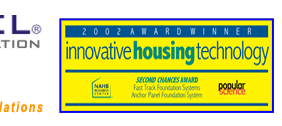 |
    |
| The Anchorpanel® Perimeter Foundation Using economical and durable materials, in a method so simple and easy that it is patented, the Anchorpanel solution is faster, stronger, cheaper and better than doing it the old way. Perhaps that is why the NAHB Research Center named it the Foundation Innovation for 2002. |
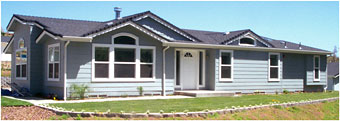
A HUD-code home foundation made invisible at Oak Tree Ranch. |
||
|
A Simple Design The Anchorpanel system is for crawl-space perimeter foundation construction, resulting in stronger anchorage, faster installation, improved disaster mitigation, increased durability, and lower cost. It enjoys an indisputable cost-efficient benefit in simply utilizing the (required) perimeter-enclosure-surface itself as the perimeter support and structural bracing system. |
|||
|
CAD Makes it Easier A set of CAD-specified corrugated shear-panels are initially hung onto any type of a pre-situated "guide", be it a staked-board, a supported floor system, or an in-place home (new manufactured home or retrofit of older home). This reverse-sequence construction vastly improves field-labor efficiency for component-housing installation, in that it allows easy duplication of prefabricated geometry. |
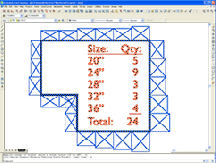 |
||
|
Anchorpanel concrete placed at the same time as slab & other work. |
Faster Completion For site-built homes, floors can be supported and framed first, then plumbed, ducted and wired while foundation construction is underway- allowing compressed schedules and avoiding weather exposure while vulnerable. For
manufactured homes, the Anchorpanel perimeter is easily attached to a
home already set upon interior supports, thereby satisfying all
anchoring and perimeter-support requirements, and creating a permanent
crawl-space that can be backfilled against. Home installations are made
easier. |
||
|
ANCHORPANEL IS SUPER STRONG: Heavy corrugations serve as bearing-wall studs 6” o/c, and it has a solid-steel shear panel built in, without any fasteners! ICC-ER testing results exceed all design requirements. |
|||
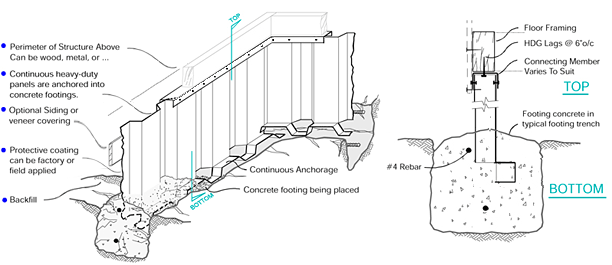
VIEW FROM THE INTERIOR DURING CONCRETE PLACEMENT 18 Gage galvanized panels safely support 3000 plf bearing and 1000 plf shear. Protective coating added. |
|||
|
Panel Installation Summary: Panels are made to the lengths that you need, to the nearest four-inch increment. For sloping sites, just provide the distance down to the trench at building corners etc, and our software figures out all the required lengths of panels, and provides a layout diagram for their installation. Crawlspace vents in the panels can be provided per your request. |
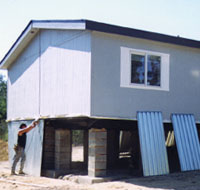
A layout diagram shows where different length panels go. |
||||
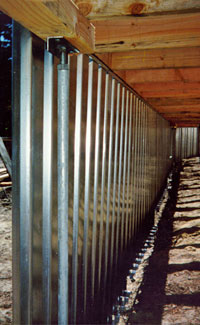
Panels hung and ready for concrete. |
After the panels and rebar are positioned, concrete can go into the footing trench. If an inspection is required first, this opportunity allows everything to be inspected, because everything relevant is visible at this time. If concrete is to be pumped in, that process takes about an hour. Where there is access on only one side of the panels, a concrete pump is essential. The concrete is pumped intermittently to the inside and then outside of each panel, all along the trench. Typically the panels are checked and set plumb as required while the concrete is setting up. | 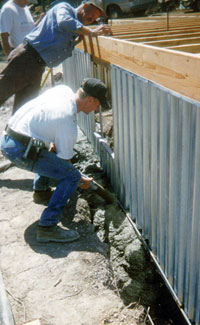
Two-story footing concrete going in. |
|||
|
Anchorpanel is impervious to water damage. |
If the panels being installed are not those already polymer coated, then they should always be field coated before backfilling any soil. Inexpensive appropriate coatings are either a coal tar emulsion or a cemtitous mix (recipe in TECHNICAL). In any case, with the proper openings, the panel system meets FEMA flood and multi-hazard mitigating foundation design, and is suitable for supporting your home over 100-year flood plains. |
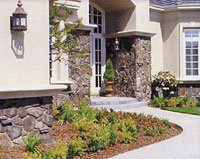
The panels make a durable support for cladding. |
What’s missing? In all, this process has avoided the foundation construction layout, concrete stemwall forming, block setting and grouting, moving the home over and fitting it to the foundation, and any subsequent attachment of home to foundation. Using Anchorpanel rather than grouted block has also avoided any number of disrupting building department inspections, depending upon your jurisdiction. And of course, any type of interior anchor or pier-brace system designed for manufactured homes is totally redundant and unnecessary. |
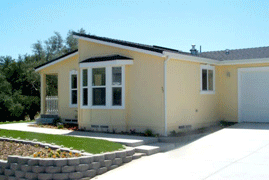
The Anchorpanel foundation makes factory-built homes easy to set low, and attach garages.
|
 |